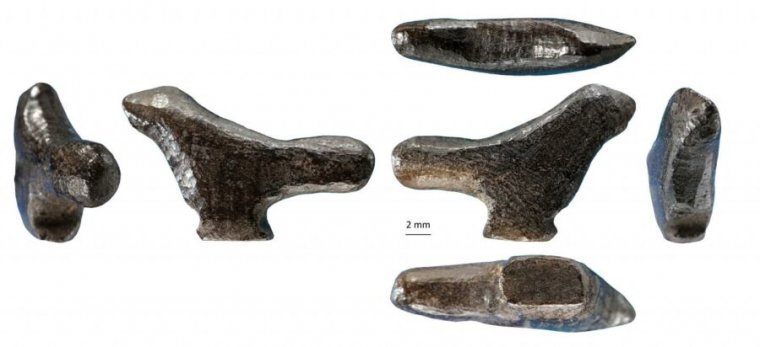
The figurine is a small songbird, about 19.2mm (0.75 inches) long, standing on a pedestal. It's carved from a burned, blackened fragment of animal bone. Whoever created it was probably a hunter-gatherer living at Lingjing, in northern China, near the end of the last Ice Age; their culture also made simple pottery and shaped black chert into small, sharp blades. To modern eyes, the carving looks pretty simple, but it’s the work of an artist who knew how to combine several techniques (and work with multiple tools) to shape a figure out of bone. And that means that by the time the ancient artist put tool to bone 13,300 years ago, people in northern China had already developed a long and unique tradition of carved bone art.
The songbird in the well
In 1958, a few years before archaeologists realized how much of the past lay buried at Lingjing, construction crews dug a well about 5 meters (16.4 feet) down, scooping out sediment that had accumulated during the end of the last Ice Age. The well-diggers piled all the dirt up nearby without paying much attention to the ancient potsherds, stone tools, and other artifacts mixed in with it.
When Shandong University archaeologist Zhanyang Li and colleagues found the pile in 2005, they realized that they’d been quite lucky; normally, the well-digging would have mixed together artifacts from different layers, making it impossible to tell when anything had come from. But the 1958 crew happened to dig their well in a part of the site where nothing had been buried since the Paleolithic. The only artifacts in their pile of discarded dirt were small black chert blades and coarsely made pottery—distinctive objects very similar to those found in a layer at Lingjing dating to between 14,000 and 13,000 years ago. Those were mixed with charcoal and burned animal bones that radiocarbon dated to around 13,300 years ago.
Over the last 100,000 years or so, people gradually invented ways to use paintings, sculptures, and jewelry to express ideas, identify themselves, and tell stories. Art began in Africa during the Middle Stone Age, around the time the first members of our species were venturing out into the geographic crossroads of the Levant. But new forms also appeared in Eurasia, where recent finds suggest that Neanderthals were painting cave walls and making shell beads by the time Homo sapiens moved in with their own artistic traditions.
As our species spread around the world, ancient people left behind paintings in caves and rock shelters to mark their presence. By at least 42,000 years ago, cave painting flourished in Borneo and Sulawesi. The oldest known carvings are small people and animals carved from mammoth ivory around 40,000 years ago in central Europe. But we don’t yet know for sure whether the idea of carving 3D figures popped up independently at different times and places, or whether it started in one place and spread as people migrated around the world.
The little bird from Lingjing seems to be a hint that people in eastern Asia invented their own art forms. Zhanyang Li and colleagues say it may be “the first known instance of an original artistic tradition.”
Heat to 300⁰C for about an hour
In other words, the figurine is carved from a different material, using different techniques, and in a different style than anything archaeologists have found in western Europe or Siberia. People in other parts of the world were carving birds around the same time as the artist at Lingjing, but none of them were carved with a pedestal to help them stand upright, and they’re usually birds of prey rather than songbirds.
Most of the Paleolithic carvings archaeologists have found, like the ones in Europe, are ivory, but at Lingjing, the artist used burned, blackened bone—probably a fragment from the shaft of a local mammal’s limb bone, based on micro-CT scans of the material's structure. And the ancient artist seems to have heat-treated the bone especially for carving.
If you just toss a bone into a fire, or even hold it over an open flame, it’s likely to crack, shrink, and warp from the heat. But if you heat bone at very low temperatures for just the right amount of time and keep oxygen away from it, you get bone that looks like what Zhanyang Li and colleagues found at Lingjing: completely blackened, but with its structure undamaged. That’s not the kind of thing you get right on the first try; it takes specialized knowledge, which probably means this carving technique was already deeply ingrained in local tradition when the Lingjing artist learned it 13,300 years ago.
A closer look
Zhanyang Li and colleagues scanned the figurine with a micro-CT scanner and then mapped the tiny details of its surface with a microscope, and it looks like the next step in the figurine's creation involved grinding the burned fragment with a coarse grindstone, then roughing out the general shape of the bird with something like a stone chisel. Next, it looks like the artist used sharp stone scrapers to smooth and refine the final shape, then incised lines on the bird’s head for the eyes and bill.
The microscopic analysis also revealed that many of those grinding, chiseling, and scraping marks had been rubbed smooth, but probably not on purpose. Striations crisscrossed each other in random directions, and they matched the kind of wear you’d expect to see on an object that someone carried around in a leather bag for a long time. That’s our only hint about what the bird figurine was for.
PLOS ONE, 2020 DOI: 10.1371/journal.pone.0233370 (About DOIs).
reader comments
35